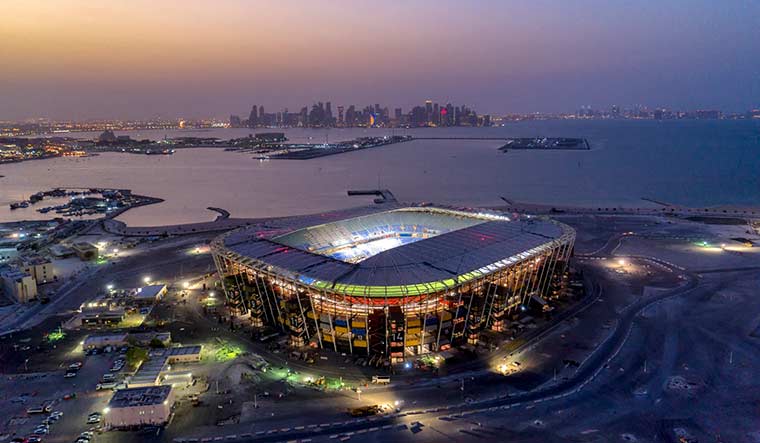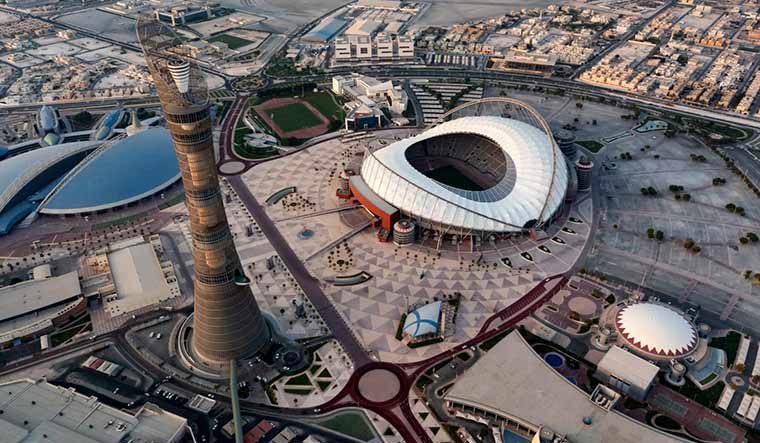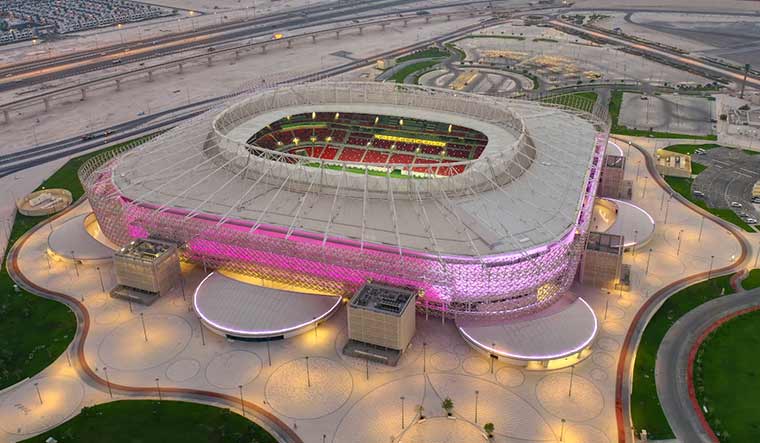Our original idea was inspired by a LEGO set, said Mohammed Al Mulla. If you were trying to guess what Al Mulla was referring to, a football stadium must not have been on the top of your mind. Yet, that is the origin story of the innovative Stadium 974 in Qatar. The 40,000-capacity venue in Doha is the first fully demountable stadium in the history of the FIFA World Cup. It has been built using recycled shipping containers and modular steel elements.
Al Mulla, the engineer who was in charge of the stadium, told the official Qatar 2022 website that it was one of a kind and a blueprint for future hosts of mega events. “Fans will be amazed, especially about the fact that concession stands, toilets and medical rooms are all shipping containers,” he said. The 974 in the name denotes the number of shipping containers used. It is also Qatar’s international dialling code. According to Al Mulla, Stadium 974 is the first venue fans will see when they arrive in Qatar. A colourful and distinctive welcome, no doubt, but Stadium 974 is only the appetiser before the elaborate feast that Qatar has prepared for football fans.
And, “prepared” is not jumping the gun. Seven out of the eight World Cup stadiums are ready. Only the venue for the final, the Lusail Stadium (coming up in the newly built metropolis of Lusail—15km north of central Doha) remains to be completed. No surprise then that FIFA president Gianni Infantino recently said that he had never seen a country so ready to host a World Cup. “The infrastructure is ready, which means that for the next year, we can focus on making sure that every fan coming to Qatar will have an incredible experience,” he said.
To be at this stage of preparations with one year to go is impressive. But, then again, there was never any doubt with regard to the effort the country would put in. When Qatar won the bid in 2010, the immediate response was scepticism. This turned to outrage when allegations of bribery surfaced. Though heads rolled within FIFA, Qatar came out of the scandal with its hosting rights intact. Critics continued to attack it, though words like bribery had now been replaced with “financial muscle”.
The summer heat in Qatar was a major point of concern. In its bid, the country had promised environment-friendly stadium cooling technology. And despite the fact that the event was moved to the cooler November-December months, the Supreme Committee for Delivery and Legacy (SC)—the body responsible for the implementation of host country operations—continued to develop cooling technology in order to create a strong legacy. In its search for cooling solutions, the SC reached out to Qatar University and found “Dr Cool”. Sudan-born Saud Abdulaziz Abdul Ghani is a professor at the university’s College of Engineering. The cooling technology he developed for the World Cup stadiums combines insulation (keeping the cool air in and hot air out) with what Saud calls spot cooling (cooling only places where there are people). Also, the cooled air which is pushed out is drawn back, re-cooled, filtered and sent out again. This means that the technology is an estimated 40 per cent more sustainable than existing methods. Moreover, the cooling system needs to be switched on only two hours before a match.
The next logical step was to cool public spaces in Qatar. The Katara Plaza was unveiled as, reportedly, the world’s first open-air, air-conditioned plaza. Another project, Aspire Park, has a cooled walkway that uses solar panels to generate energy. Saud wants his technology to be adopted in other countries with warm climates. “The reason I joined the 2022 team was to serve the Arab region so that people here appear to others around the world in a different light,” he said in 2019. “The Middle East has a lot to offer and there’s nothing better than football to show that.”
Another argument raised to question Qatar’s suitability as a host nation was its size—how would such a tiny country accommodate the teams and fans? But, Qatar had presented this perceived weakness as its greatest strength. As per FIFA’s bid evaluation report, the Qatar bid presented a “novel approach” of a concentration of almost all key event facilities and venues in a relatively compact area, within a radius of 60km. The compactness was sold as an advantage in terms of the ease of travel and security. Other key selling points were the commitment to sustainability and the promise to use modular sections of the venues to build 22 stadiums in developing countries after the World Cup.
The focus on environmental sustainability goes well beyond the cooling system and is reflected in the use of solar energy, recycled water for irrigation and landscape conservation planning. All stadiums are on track to receive at least a four-star certification from the Global Sustainability Assessment System. Indians can take pride that among them is the Ahmad Bin Ali Stadium in Al Rayyan which was built jointly by Larsen & Toubro and its Qatari partner, Al Balagh Trading & Contracting. After a visit to the stadium in December 2020, External Affairs Minister S. Jaishankar tweeted that L&T had enhanced India’s reputation for quality and delivery.
The quantum of work being done in Qatar has led to speculations, primarily in the western media, about the money being spent on the preparations. Some reports have claimed the spending to be in hundreds of billions. Hassan Al Thawadi, secretary general, SC, has clarified that while the spending on infrastructure since 2010 is projected to be around $200 billion, the direct costs of the World Cup (stadiums and training grounds) have been closer to $6 billion.
The rest, including the new metro system, is in line with Qatar’s National Vision 2030, which aims to transform Qatar into an “advanced society capable of sustaining its development and providing a high standard of living for its people”. Several projects that were already part of Vision 2030 were simply advanced to meet the World Cup deadline. But, it must be noted that the budget for stadium construction and renovation was only $3 billion, as per the bid. Still, it could be argued that nobody else needs to fret if a cash-rich gulf country doubled its own stadium budget. However, what the world cannot turn a blind eye to are the allegations of human rights violations.
In 2017, following documentation of the abuse of low-paid migrant workers, the Qatar government signed an agreement with the International Labour Organization (ILO), committing to a “three-year, wide ranging reform process”. Qatar and the ILO agreed to “align [Qatar’s] laws and practices with international labour standards and fundamental principles and rights at work”. Labour reforms, including ending the exploitative kafala system (which bound foreign workers to their employers), were enacted. But, an Amnesty report—Reality Check 2021—alleged that “weak implementation and gaps in the measures introduced have meant that over the last year, many abusive practices have re-emerged, seriously undermining the reform process”.
The accusations against Qatar by media and human rights organisations prompted a few European national teams to stage protests during the qualifying rounds. But, the host nation has made it a point to respond to such allegations. For instance, when it was recently reported that Norwegian broadcast journalists were detained after trying to report on the condition of workers, Qatar’s Government Communications Office responded that they were detained for trespassing on private property and filming without a permit. “The crew... were provided with all the filming permits they had requested prior to their arrival and were offered meetings with senior government and third-party officials. These freedoms, however, do not override the rule of law. As in almost every country, trespassing is against Qatari law,” the statement read.
Similarly, when The Guardian reported that at least 6,500 migrant labourers from India, Pakistan, Nepal, Bangladesh and Sri Lanka had died in Qatar since it won the bid in 2010, the communications office responded that over 1.4 million expatriates from these countries had lived in Qatar over the period in question. The statement indicated that not all who died were labourers. It further added that “although each loss of life is upsetting”, the mortality rate among these communities was within the expected range for the size and demographics of the population.
In November, another report by The Guardian featured hotel workers who alleged that they had been mistreated and exploited. This time, Qatar’s response said that the reporting failed to acknowledge the progress it had made to improve living and working standards for foreign workers. “Not a single story from among the thousands of people who have benefited from Qatar’s labour reforms is highlighted in the article. Qatar has never shied away from acknowledging that its labour system is still a work in progress, but we expect reporting to present the facts as they stand. Going forward, Qatar remains firmly committed to cooperation, transparency and continuous improvement of its labour system,” read the response from Fahad Al-Mana, media attaché to the UK.
If the allegations of corruption and abusive work conditions were not enough, Qatar also had to contend with an economic blockade led by its neighbours, followed by Covid-19. Through it all, the country has stayed on track. And while the scrutiny on its labour reforms and human rights record will continue, Qatar can now look forward to reaping the rewards of its work over the last decade. But, what can fans expect? The SC has said that there would be accommodation options suitable to all pockets—five-star, three-star, service apartments, desert camps and cruise ships. The variety in the options is also noteworthy since it allows Qatar to host the event without adding new hotel rooms, which would not be needed after the World Cup.
The sale of alcohol is restricted in the country and the price is relatively high. For the World Cup, it is expected that alcohol will be available in designated fan zones for lower prices than usual. However, it is an offence to drink in public or be “drunk on a main road”, or, disturb others while intoxicated. Therefore, the usual drunken antics of England fans, for instance, are unlikely to go down well. Qatar has strict anti-LGBTQ+ laws. However, it has said that it would comply with FIFA rules promoting tolerance and inclusion. Therefore, rainbow flags or other such symbols are not likely to cause a problem. But, public displays of affection are frowned upon—this is equally applicable to heterosexual and homosexual couples.
On the footballing front, there is no doubt that the World Cup will benefit Qatar. There has already been a massive improvement in the national team. It was ranked 113 when the bid was won. Now, the team sits comfortably at 51. Much of the current national team came through the Aspire Academy—a sporting centre for excellence that has trained local talent since 2004. Qatar has done well in youth tournaments and won the AFC Asian Cup in 2019.
Attacker Almoez Ali, who was the top-scorer in the 2019 Asian Cup with nine goals, told the Qatar 2022 website that the team’s aim was not merely to take part. “We strive to make it to the furthest stage possible,” said the 25-year-old, who captains Qatar Stars League club Al-Duhail. “We are not just representing Qatar, we are representing the entire Arab world.” Ali believes that the timing of the tournament could improve performance. It kicks-off on November 21—mid-season in most leagues. “Players will be in optimal shape, as opposed to being fatigued,” said Ali.
Defender Bassam Al-Rawi, who was named in the team of the tournament in 2019, said that Qatar had been working hard both on and off the pitch for a long time. “In addition to the work being done to prepare the country to host, equal effort has been put in to develop football,” said the 24-year-old, who also plays for Al-Duhail. “This produced a team that is going into the World Cup as Asian Champions.” Clearly, there is no shortage of confidence. But, up against the best teams in the world, things will not be easy for Qatar. To live up to the expectations of the local fans, the team will have to produce performances worthy of the stage that the host country has built.








